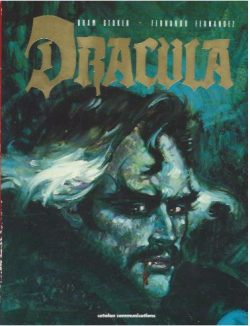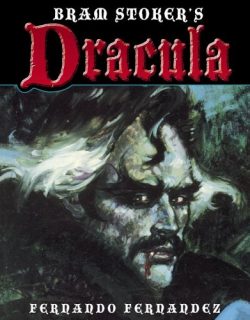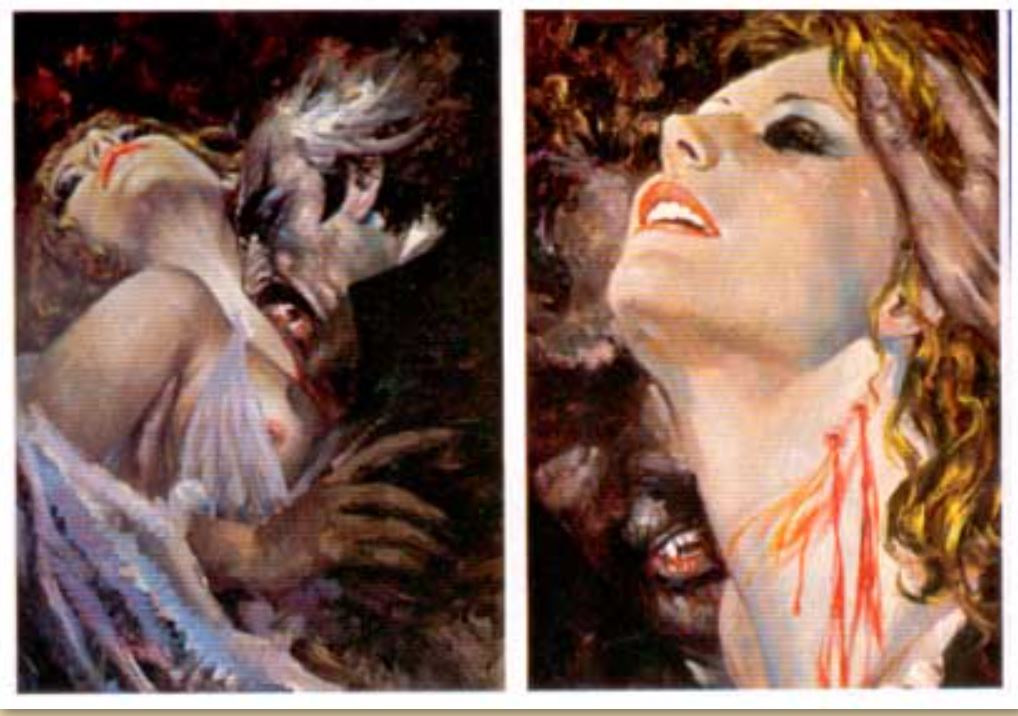

By Bram Stoker & Fernando Fernández (Catalan Communications/Del Rey Books)
ISBN: 978-0-34548-312-6 (Del Rey)
DLB: 18118-1984 (Catalan)
This book includes Discriminatory Content produced in less enlightened times
Here a gloriously OTT example of Anglo-European collaboration long overdue for reconsideration and another go-round…
Multi-disciplinary Spanish artist Fernando Fernández began working to help support his family at age 13 whilst still at High School. He graduated in 1956 and immediately began working for British and French comics publishers. In 1958 his family relocated to Argentina and whilst there he added strips for El Gorrión, Tótem and Puño Fuerte to his ongoing European and British assignments for Valentina, Roxy and Marilyn.
In 1959 he returned to Spain and began a long association with Fleetway Publications in London, generating mostly war and girls’ romance stories. By the mid-1960’s he was experimenting with painting: selling book covers and illustrations to a number of clients. He resumed comics work in 1970, creating a variety of strips (many of which found their way into US horror magazine Vampirella), the successful comedy feature ‘Mosca’ for Diario de Barcelona and educational strips for the publishing house Afha.
Increasingly expressive and experimental as the decade passed, Fernández crafted ‘Cuba, 1898’ and ‘Círculos’ before, in 1980, beginning his science fiction spectacular Zora y los Hibernautas for the Spanish iteration of US fantasy magazine 1984. It eventually made it into English via Heavy Metal magazine as Zora and the Hibernauts.
He then adapted this moody, Hammer Films-influenced version of Dracula for the Spanish iteration of Creepy, before (working with Carlos Trillo) moving on to mediaeval fantasy thriller La Leyenda de las Cuatro Sombras. That done, he created illustration series Galería de Personajes Fantásticos, Argón, el Salvaje and a number of adaptations of Isaac Asimov tales in Firmado por: Isaac Asimov and Lucky Starr – Los Océanos de Venus.
His last comics work was Zodíaco, begun in 1989, before mounting heart problems curtailed the series and he returned to painting and illustration. He died in August 2010, aged 70.
For his interpretation of the gothic masterpiece under review here, Fernández sidelined the expansive, experimental layouts and lavish page design that had worked so effectively in Zora and the Hibernauts, opting for a moodily classical and oppressively claustrophobic, traditional page construction: trusting to his staggering mastery of colour and form to carry his luxuriously mesmeric message of mystery, seduction and terror.
The story is undoubtedly a familiar one and the set pieces are all executed with astounding skill and confident aplomb as, in May 1897, English lawyer Jonathan Harker is lured to the wilds of Transylvania and horror beyond imagining wherein an ancient bloodsucking horror prepares to move to the pulsing heart of the modern world. Leaving Harker to the tender mercies of his vampiric harem, Dracula voyages by schooner to England, slaughtering every seaman aboard the S.S. Demeter and unleashing a reign of terror throughout the sedate, complacent British countryside.
Meanwhile, in the seat of Empire, Harker’s fiancée Mina Murray finds her flighty friend Lucy Westenra fading from troublesome dreams and an uncanny lethargy which none of her determined suitors, Dr. Jack Seward, Texan Quincy P. Morris and Arthur Holmwood – the future Lord Godalming – seem capable of dispelling…
As Harker struggles to survive in the Carpathians, in Britain, Seward’s deranged but impotent patient Renfield confesses to horrifying visions and becomes greatly agitated. Freshly arrived in England, the Count is already causing chaos and disaster, as well as constantly returning to rapidly declining Lucy. His bestial bloodletting prompts her three beaux to summon famed Dutch physician Abraham Van Helsing to save her life and cure her increasing mania.
Harker survived his Transylvanian ordeal, and when nuns summoned Mina she rushed to Romania where she married him in a hasty ceremony to save his health and wits…

In London, Dracula renews his assaults and Lucy dies, only to be reborn as a predatory child-killing monster. After dispatching her to eternal rest, Van Helsing, Holmwood, Seward & Morris – joined by recently returned and much-altered Harker and his new bride – resolve to hunt down and destroy the ancient evil in their midst, following a chance encounter in a London street between the newlyweds and the astoundingly rejuvenated Count…
Dracula, however, has incredible forces and centuries of experience on his side and having tainted Mina with his blood-drinking curse flees back to his ancestral lands. Frantically, the mortal champions give chase, battling the elements, Dracula’s enslaved “gypsy army” and the monster’s horrific eldritch power in a race against time lest Mina finally succumb forever to his unholy influence…
Although translation to English in the Catalan version is a little slapdash in places – a fact happily addressed in a 2005 re-release from Del Rey – the original does have the subtly enhanced benefit of richer colours, sturdier paper stock and a slightly larger page size (285 x 219mm as opposed to 274 x 211mm) which somehow makes the 1984 edition feel more substantial. Of course, this would all be irrelevant if a digital edition were available.
This breathtaking take on the oft-retold yarn delivers fast paced, action-packed, staggeringly beautiful and astoundingly exciting thrills and chills in a most beguiling manner. Being Spanish, however, there’s perhaps the slightest hint of brooding machismo, if not subverted sexism, on display and – of course – plenty of heaving, gauze-filtered female nudity which might challenge modern sensibilities.
Nevertheless, what predominates in this Dracula is an overwhelming impression of unstoppable evil and impending doom. There’s no sympathy for the devil here – this is a monster from Hell all good men must oppose to their last breath and final drop of blood and sweat…
With an emphatic introduction (‘Dracula Lives!’) from comics historian Maurice Horn, this is a sublime treatment by a master craftsman all dark-fearing, red-blooded fans will want to track down and savour.
© 1984, 2005 Fernando Fernández. All rights reserved.
Today in 1894 letterer Ira Schnapp was born. I haven’t even listed most of his work on Now Read This!, but you’ve appreciated some of it every time you saw a golden age Superman logo.
Simultaneously culturally significant and insensitive, today in 1953 saw the first appearance of Leo Baxendale’s Little Plum in The Beano. You can weigh his pros and cons for yourself with Dandy and Beano Present The Comics at Christmas or any 20th century Beano Annual we’ve reviewed.
In 1957 Rumiko Takahashi was born. We covered Mermaid Forest so long ago it’s probably time for a revisit, and we should probably do Ranma ½ while we’re at it…
In 1959 the last episode of Norman Pett’s Jane was published. It had begun in 1932, but once you’ve seen The Misadventures of Jane you’ll probably agree it was best to let her go.
